Flood Risk and Opportunity for Resilience in Chennai, India
VerifiedAdded on 2023/06/08
|26
|10457
|421
Thesis and Dissertation
AI Summary
This dissertation delves into the critical issue of flood risk and the potential for resilience in Chennai, India. The study begins with an introduction to global flooding scenarios, highlighting the specific challenges faced by Chennai, which is prone to severe flooding events. It emphasizes the importance of sustainable flood management (SFM) and outlines the research aims, objectives, and questions. The literature review examines the suitability of SFM as a coping strategy, explores the types of flooding in Chennai, and analyzes government responses. It also identifies limitations in SFM implementation and examines both structural and non-structural measures. The research investigates the causes and consequences of floods, including climate change and inadequate planning. It further explores the need for strategic frameworks, nature-based solutions, and improved water disposal systems. The dissertation also highlights the significance of sustainable flood management plans and the importance of restoring natural floodplains. The research aims to identify effective SFM measures suitable for Chennai, considering both existing practices and potential policy changes. The study seeks to inform and provide insights into mitigating flood risks and building resilience in the city.
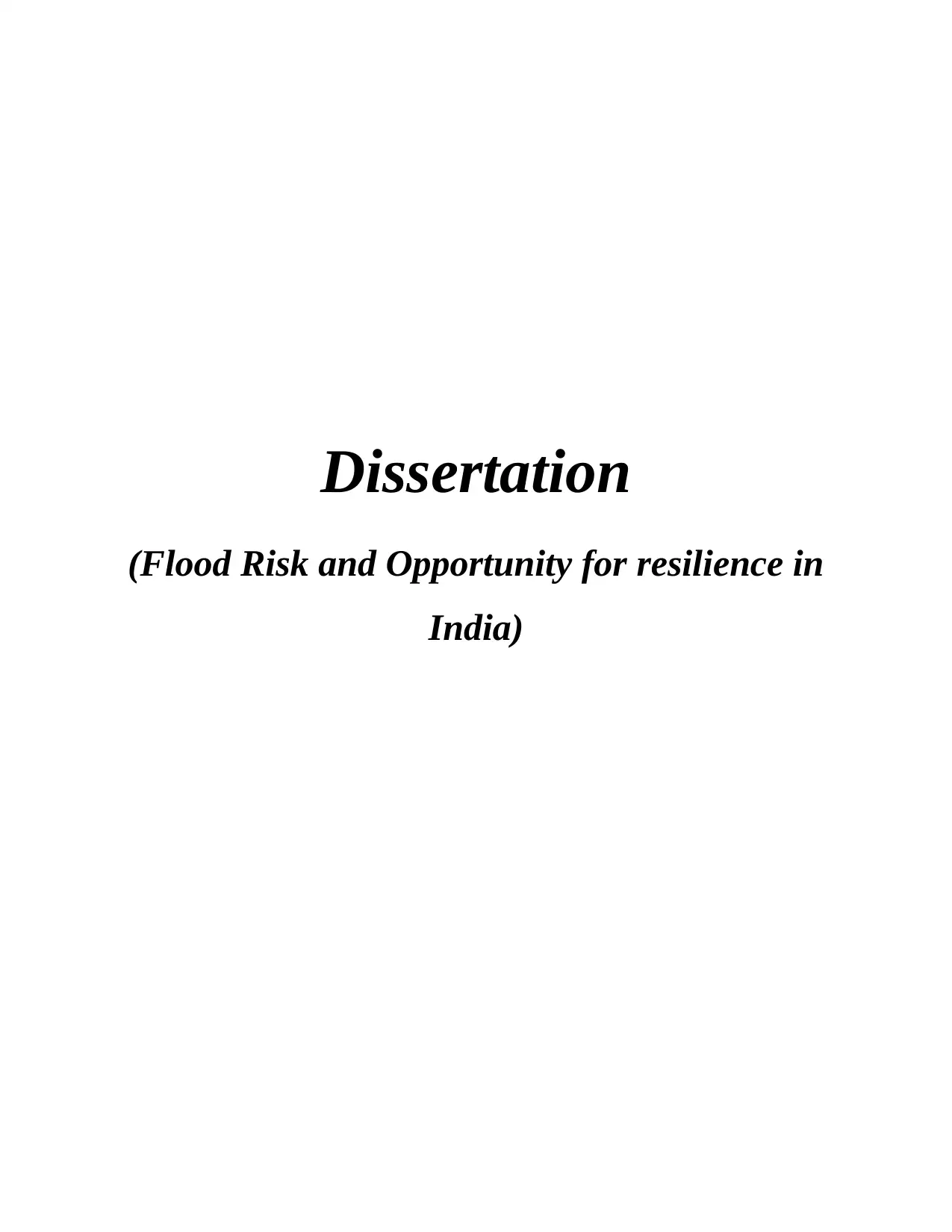
Dissertation
(Flood Risk and Opportunity for resilience in
India)
(Flood Risk and Opportunity for resilience in
India)
Paraphrase This Document
Need a fresh take? Get an instant paraphrase of this document with our AI Paraphraser
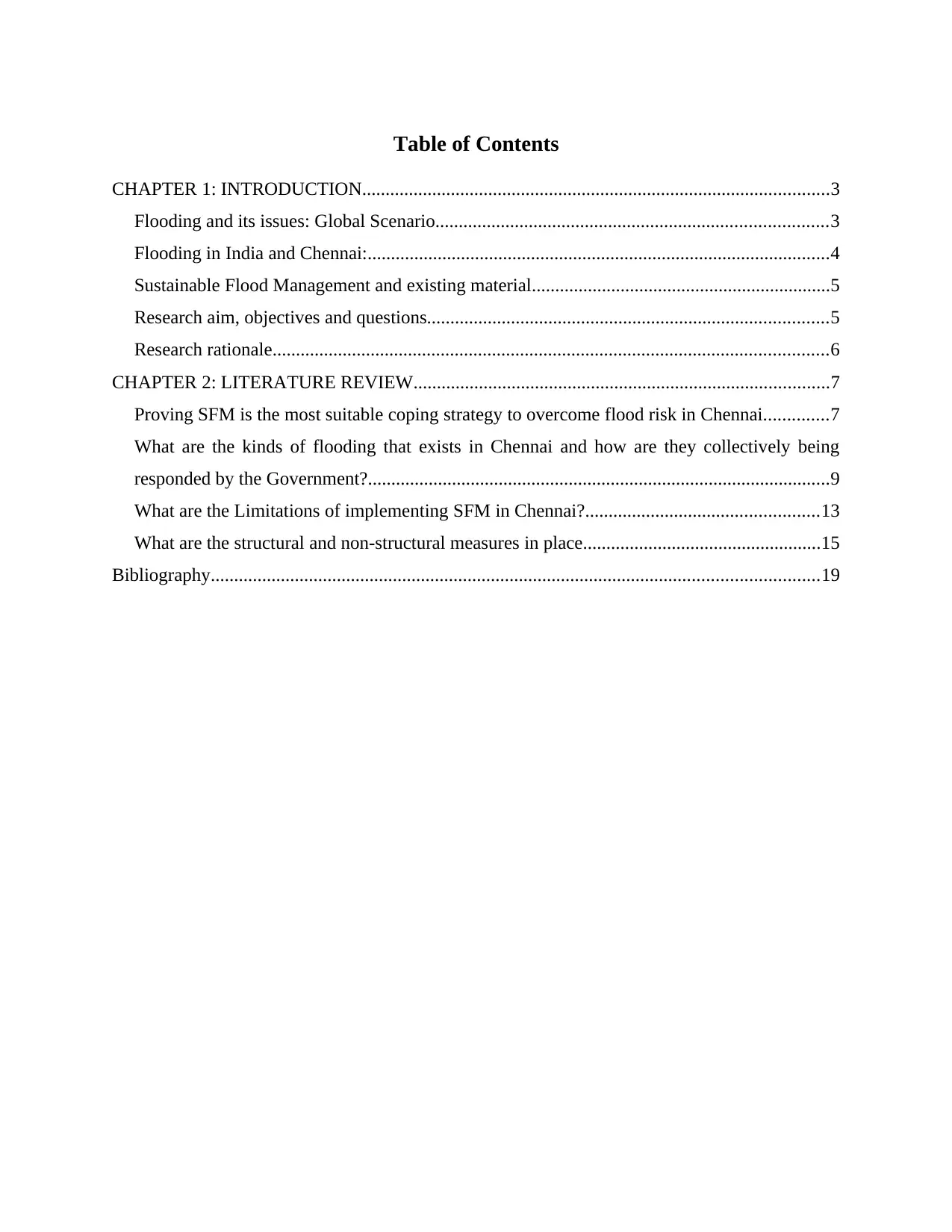
Table of Contents
CHAPTER 1: INTRODUCTION....................................................................................................3
Flooding and its issues: Global Scenario....................................................................................3
Flooding in India and Chennai:...................................................................................................4
Sustainable Flood Management and existing material................................................................5
Research aim, objectives and questions......................................................................................5
Research rationale.......................................................................................................................6
CHAPTER 2: LITERATURE REVIEW.........................................................................................7
Proving SFM is the most suitable coping strategy to overcome flood risk in Chennai..............7
What are the kinds of flooding that exists in Chennai and how are they collectively being
responded by the Government?...................................................................................................9
What are the Limitations of implementing SFM in Chennai?..................................................13
What are the structural and non-structural measures in place...................................................15
Bibliography..................................................................................................................................19
CHAPTER 1: INTRODUCTION....................................................................................................3
Flooding and its issues: Global Scenario....................................................................................3
Flooding in India and Chennai:...................................................................................................4
Sustainable Flood Management and existing material................................................................5
Research aim, objectives and questions......................................................................................5
Research rationale.......................................................................................................................6
CHAPTER 2: LITERATURE REVIEW.........................................................................................7
Proving SFM is the most suitable coping strategy to overcome flood risk in Chennai..............7
What are the kinds of flooding that exists in Chennai and how are they collectively being
responded by the Government?...................................................................................................9
What are the Limitations of implementing SFM in Chennai?..................................................13
What are the structural and non-structural measures in place...................................................15
Bibliography..................................................................................................................................19
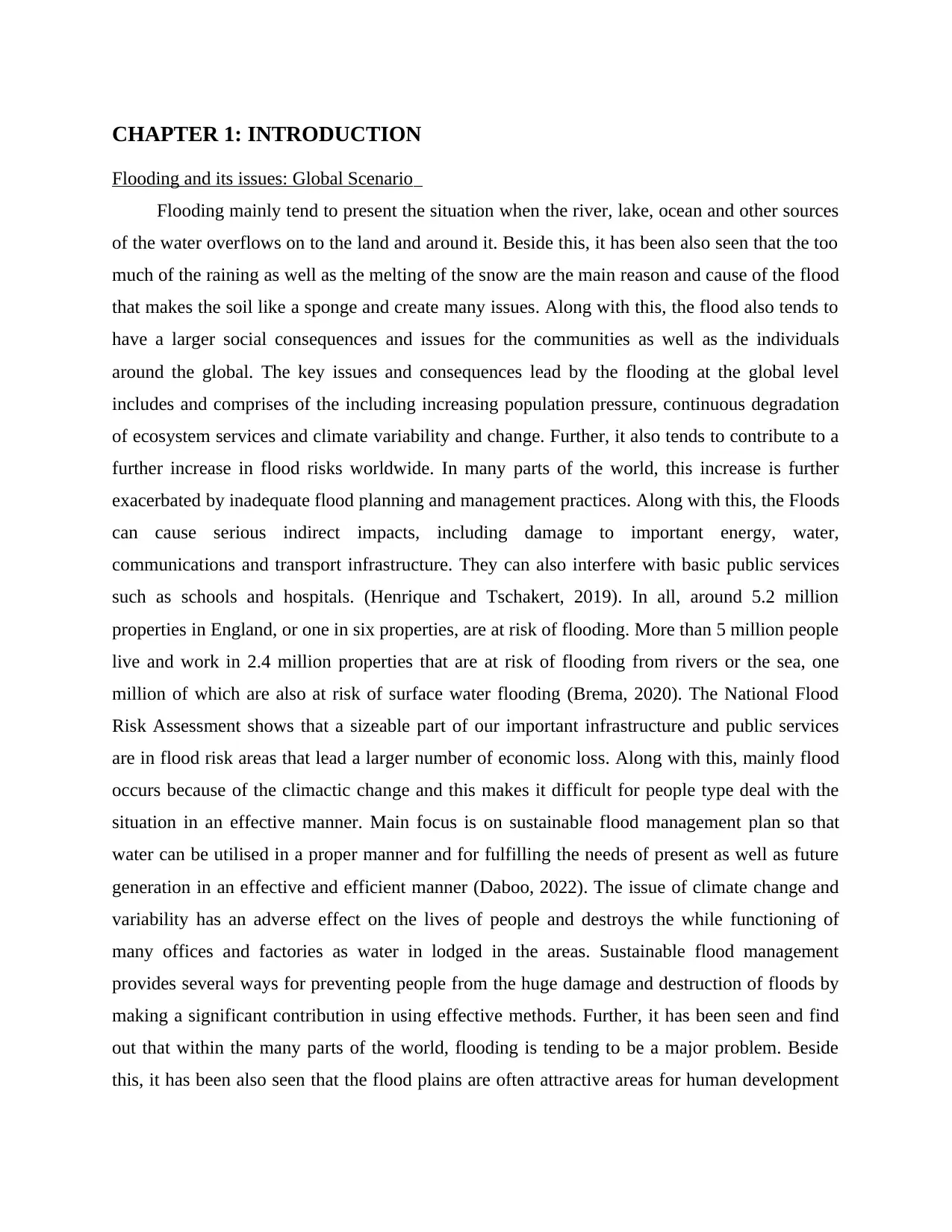
CHAPTER 1: INTRODUCTION
Flooding and its issues: Global Scenario
Flooding mainly tend to present the situation when the river, lake, ocean and other sources
of the water overflows on to the land and around it. Beside this, it has been also seen that the too
much of the raining as well as the melting of the snow are the main reason and cause of the flood
that makes the soil like a sponge and create many issues. Along with this, the flood also tends to
have a larger social consequences and issues for the communities as well as the individuals
around the global. The key issues and consequences lead by the flooding at the global level
includes and comprises of the including increasing population pressure, continuous degradation
of ecosystem services and climate variability and change. Further, it also tends to contribute to a
further increase in flood risks worldwide. In many parts of the world, this increase is further
exacerbated by inadequate flood planning and management practices. Along with this, the Floods
can cause serious indirect impacts, including damage to important energy, water,
communications and transport infrastructure. They can also interfere with basic public services
such as schools and hospitals. (Henrique and Tschakert, 2019). In all, around 5.2 million
properties in England, or one in six properties, are at risk of flooding. More than 5 million people
live and work in 2.4 million properties that are at risk of flooding from rivers or the sea, one
million of which are also at risk of surface water flooding (Brema, 2020). The National Flood
Risk Assessment shows that a sizeable part of our important infrastructure and public services
are in flood risk areas that lead a larger number of economic loss. Along with this, mainly flood
occurs because of the climactic change and this makes it difficult for people type deal with the
situation in an effective manner. Main focus is on sustainable flood management plan so that
water can be utilised in a proper manner and for fulfilling the needs of present as well as future
generation in an effective and efficient manner (Daboo, 2022). The issue of climate change and
variability has an adverse effect on the lives of people and destroys the while functioning of
many offices and factories as water in lodged in the areas. Sustainable flood management
provides several ways for preventing people from the huge damage and destruction of floods by
making a significant contribution in using effective methods. Further, it has been seen and find
out that within the many parts of the world, flooding is tending to be a major problem. Beside
this, it has been also seen that the flood plains are often attractive areas for human development
Flooding and its issues: Global Scenario
Flooding mainly tend to present the situation when the river, lake, ocean and other sources
of the water overflows on to the land and around it. Beside this, it has been also seen that the too
much of the raining as well as the melting of the snow are the main reason and cause of the flood
that makes the soil like a sponge and create many issues. Along with this, the flood also tends to
have a larger social consequences and issues for the communities as well as the individuals
around the global. The key issues and consequences lead by the flooding at the global level
includes and comprises of the including increasing population pressure, continuous degradation
of ecosystem services and climate variability and change. Further, it also tends to contribute to a
further increase in flood risks worldwide. In many parts of the world, this increase is further
exacerbated by inadequate flood planning and management practices. Along with this, the Floods
can cause serious indirect impacts, including damage to important energy, water,
communications and transport infrastructure. They can also interfere with basic public services
such as schools and hospitals. (Henrique and Tschakert, 2019). In all, around 5.2 million
properties in England, or one in six properties, are at risk of flooding. More than 5 million people
live and work in 2.4 million properties that are at risk of flooding from rivers or the sea, one
million of which are also at risk of surface water flooding (Brema, 2020). The National Flood
Risk Assessment shows that a sizeable part of our important infrastructure and public services
are in flood risk areas that lead a larger number of economic loss. Along with this, mainly flood
occurs because of the climactic change and this makes it difficult for people type deal with the
situation in an effective manner. Main focus is on sustainable flood management plan so that
water can be utilised in a proper manner and for fulfilling the needs of present as well as future
generation in an effective and efficient manner (Daboo, 2022). The issue of climate change and
variability has an adverse effect on the lives of people and destroys the while functioning of
many offices and factories as water in lodged in the areas. Sustainable flood management
provides several ways for preventing people from the huge damage and destruction of floods by
making a significant contribution in using effective methods. Further, it has been seen and find
out that within the many parts of the world, flooding is tending to be a major problem. Beside
this, it has been also seen that the flood plains are often attractive areas for human development
⊘ This is a preview!⊘
Do you want full access?
Subscribe today to unlock all pages.

Trusted by 1+ million students worldwide
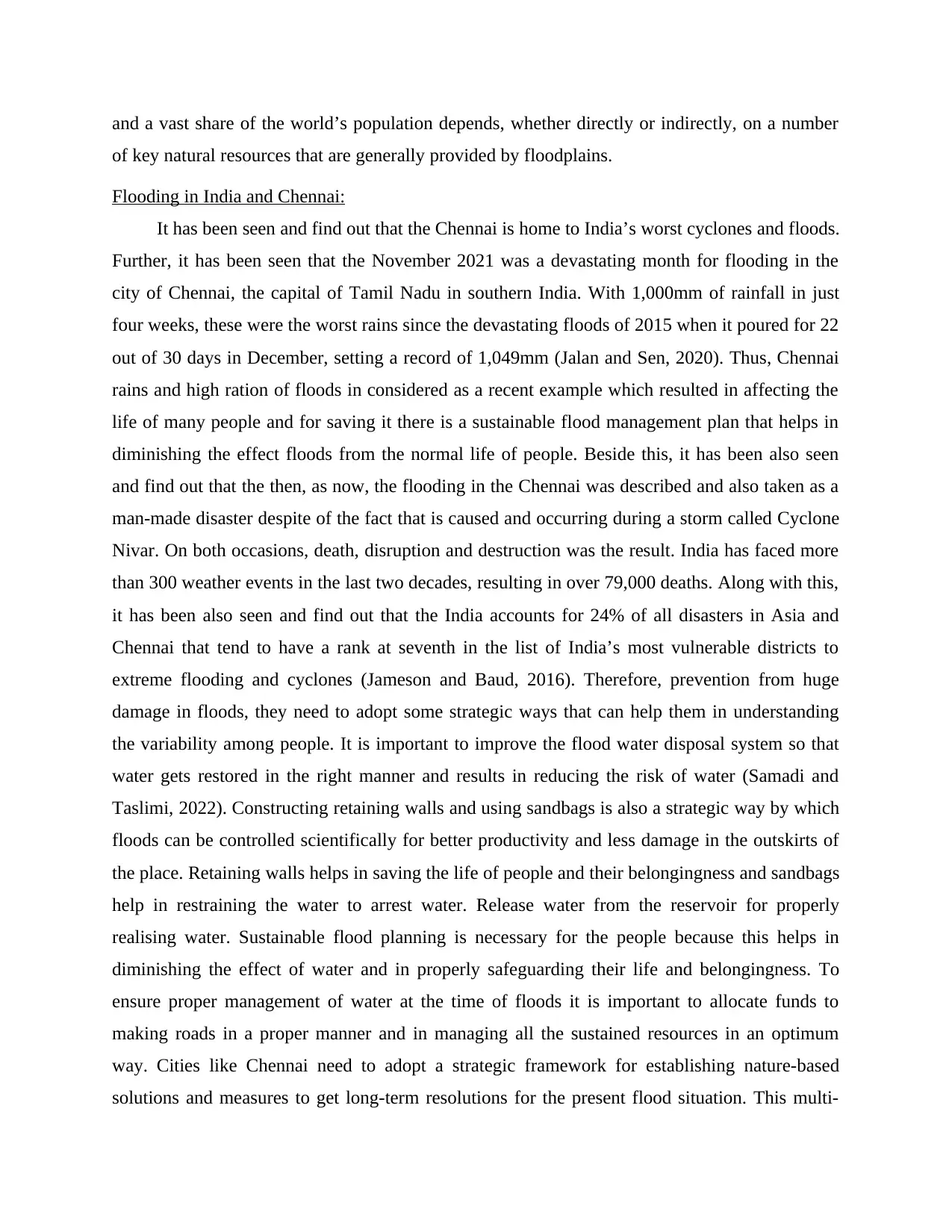
and a vast share of the world’s population depends, whether directly or indirectly, on a number
of key natural resources that are generally provided by floodplains.
Flooding in India and Chennai:
It has been seen and find out that the Chennai is home to India’s worst cyclones and floods.
Further, it has been seen that the November 2021 was a devastating month for flooding in the
city of Chennai, the capital of Tamil Nadu in southern India. With 1,000mm of rainfall in just
four weeks, these were the worst rains since the devastating floods of 2015 when it poured for 22
out of 30 days in December, setting a record of 1,049mm (Jalan and Sen, 2020). Thus, Chennai
rains and high ration of floods in considered as a recent example which resulted in affecting the
life of many people and for saving it there is a sustainable flood management plan that helps in
diminishing the effect floods from the normal life of people. Beside this, it has been also seen
and find out that the then, as now, the flooding in the Chennai was described and also taken as a
man-made disaster despite of the fact that is caused and occurring during a storm called Cyclone
Nivar. On both occasions, death, disruption and destruction was the result. India has faced more
than 300 weather events in the last two decades, resulting in over 79,000 deaths. Along with this,
it has been also seen and find out that the India accounts for 24% of all disasters in Asia and
Chennai that tend to have a rank at seventh in the list of India’s most vulnerable districts to
extreme flooding and cyclones (Jameson and Baud, 2016). Therefore, prevention from huge
damage in floods, they need to adopt some strategic ways that can help them in understanding
the variability among people. It is important to improve the flood water disposal system so that
water gets restored in the right manner and results in reducing the risk of water (Samadi and
Taslimi, 2022). Constructing retaining walls and using sandbags is also a strategic way by which
floods can be controlled scientifically for better productivity and less damage in the outskirts of
the place. Retaining walls helps in saving the life of people and their belongingness and sandbags
help in restraining the water to arrest water. Release water from the reservoir for properly
realising water. Sustainable flood planning is necessary for the people because this helps in
diminishing the effect of water and in properly safeguarding their life and belongingness. To
ensure proper management of water at the time of floods it is important to allocate funds to
making roads in a proper manner and in managing all the sustained resources in an optimum
way. Cities like Chennai need to adopt a strategic framework for establishing nature-based
solutions and measures to get long-term resolutions for the present flood situation. This multi-
of key natural resources that are generally provided by floodplains.
Flooding in India and Chennai:
It has been seen and find out that the Chennai is home to India’s worst cyclones and floods.
Further, it has been seen that the November 2021 was a devastating month for flooding in the
city of Chennai, the capital of Tamil Nadu in southern India. With 1,000mm of rainfall in just
four weeks, these were the worst rains since the devastating floods of 2015 when it poured for 22
out of 30 days in December, setting a record of 1,049mm (Jalan and Sen, 2020). Thus, Chennai
rains and high ration of floods in considered as a recent example which resulted in affecting the
life of many people and for saving it there is a sustainable flood management plan that helps in
diminishing the effect floods from the normal life of people. Beside this, it has been also seen
and find out that the then, as now, the flooding in the Chennai was described and also taken as a
man-made disaster despite of the fact that is caused and occurring during a storm called Cyclone
Nivar. On both occasions, death, disruption and destruction was the result. India has faced more
than 300 weather events in the last two decades, resulting in over 79,000 deaths. Along with this,
it has been also seen and find out that the India accounts for 24% of all disasters in Asia and
Chennai that tend to have a rank at seventh in the list of India’s most vulnerable districts to
extreme flooding and cyclones (Jameson and Baud, 2016). Therefore, prevention from huge
damage in floods, they need to adopt some strategic ways that can help them in understanding
the variability among people. It is important to improve the flood water disposal system so that
water gets restored in the right manner and results in reducing the risk of water (Samadi and
Taslimi, 2022). Constructing retaining walls and using sandbags is also a strategic way by which
floods can be controlled scientifically for better productivity and less damage in the outskirts of
the place. Retaining walls helps in saving the life of people and their belongingness and sandbags
help in restraining the water to arrest water. Release water from the reservoir for properly
realising water. Sustainable flood planning is necessary for the people because this helps in
diminishing the effect of water and in properly safeguarding their life and belongingness. To
ensure proper management of water at the time of floods it is important to allocate funds to
making roads in a proper manner and in managing all the sustained resources in an optimum
way. Cities like Chennai need to adopt a strategic framework for establishing nature-based
solutions and measures to get long-term resolutions for the present flood situation. This multi-
Paraphrase This Document
Need a fresh take? Get an instant paraphrase of this document with our AI Paraphraser
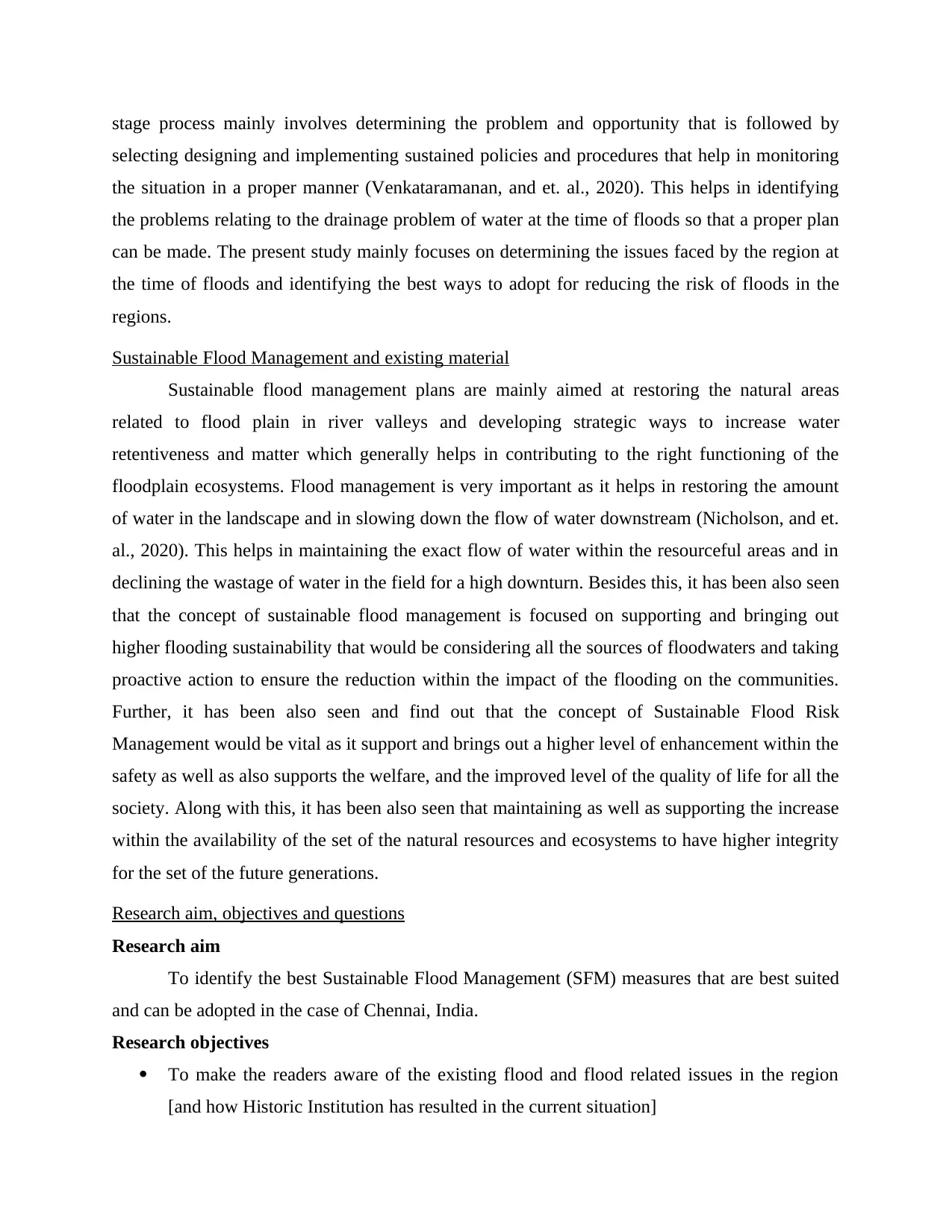
stage process mainly involves determining the problem and opportunity that is followed by
selecting designing and implementing sustained policies and procedures that help in monitoring
the situation in a proper manner (Venkataramanan, and et. al., 2020). This helps in identifying
the problems relating to the drainage problem of water at the time of floods so that a proper plan
can be made. The present study mainly focuses on determining the issues faced by the region at
the time of floods and identifying the best ways to adopt for reducing the risk of floods in the
regions.
Sustainable Flood Management and existing material
Sustainable flood management plans are mainly aimed at restoring the natural areas
related to flood plain in river valleys and developing strategic ways to increase water
retentiveness and matter which generally helps in contributing to the right functioning of the
floodplain ecosystems. Flood management is very important as it helps in restoring the amount
of water in the landscape and in slowing down the flow of water downstream (Nicholson, and et.
al., 2020). This helps in maintaining the exact flow of water within the resourceful areas and in
declining the wastage of water in the field for a high downturn. Besides this, it has been also seen
that the concept of sustainable flood management is focused on supporting and bringing out
higher flooding sustainability that would be considering all the sources of floodwaters and taking
proactive action to ensure the reduction within the impact of the flooding on the communities.
Further, it has been also seen and find out that the concept of Sustainable Flood Risk
Management would be vital as it support and brings out a higher level of enhancement within the
safety as well as also supports the welfare, and the improved level of the quality of life for all the
society. Along with this, it has been also seen that maintaining as well as supporting the increase
within the availability of the set of the natural resources and ecosystems to have higher integrity
for the set of the future generations.
Research aim, objectives and questions
Research aim
To identify the best Sustainable Flood Management (SFM) measures that are best suited
and can be adopted in the case of Chennai, India.
Research objectives
To make the readers aware of the existing flood and flood related issues in the region
[and how Historic Institution has resulted in the current situation]
selecting designing and implementing sustained policies and procedures that help in monitoring
the situation in a proper manner (Venkataramanan, and et. al., 2020). This helps in identifying
the problems relating to the drainage problem of water at the time of floods so that a proper plan
can be made. The present study mainly focuses on determining the issues faced by the region at
the time of floods and identifying the best ways to adopt for reducing the risk of floods in the
regions.
Sustainable Flood Management and existing material
Sustainable flood management plans are mainly aimed at restoring the natural areas
related to flood plain in river valleys and developing strategic ways to increase water
retentiveness and matter which generally helps in contributing to the right functioning of the
floodplain ecosystems. Flood management is very important as it helps in restoring the amount
of water in the landscape and in slowing down the flow of water downstream (Nicholson, and et.
al., 2020). This helps in maintaining the exact flow of water within the resourceful areas and in
declining the wastage of water in the field for a high downturn. Besides this, it has been also seen
that the concept of sustainable flood management is focused on supporting and bringing out
higher flooding sustainability that would be considering all the sources of floodwaters and taking
proactive action to ensure the reduction within the impact of the flooding on the communities.
Further, it has been also seen and find out that the concept of Sustainable Flood Risk
Management would be vital as it support and brings out a higher level of enhancement within the
safety as well as also supports the welfare, and the improved level of the quality of life for all the
society. Along with this, it has been also seen that maintaining as well as supporting the increase
within the availability of the set of the natural resources and ecosystems to have higher integrity
for the set of the future generations.
Research aim, objectives and questions
Research aim
To identify the best Sustainable Flood Management (SFM) measures that are best suited
and can be adopted in the case of Chennai, India.
Research objectives
To make the readers aware of the existing flood and flood related issues in the region
[and how Historic Institution has resulted in the current situation]
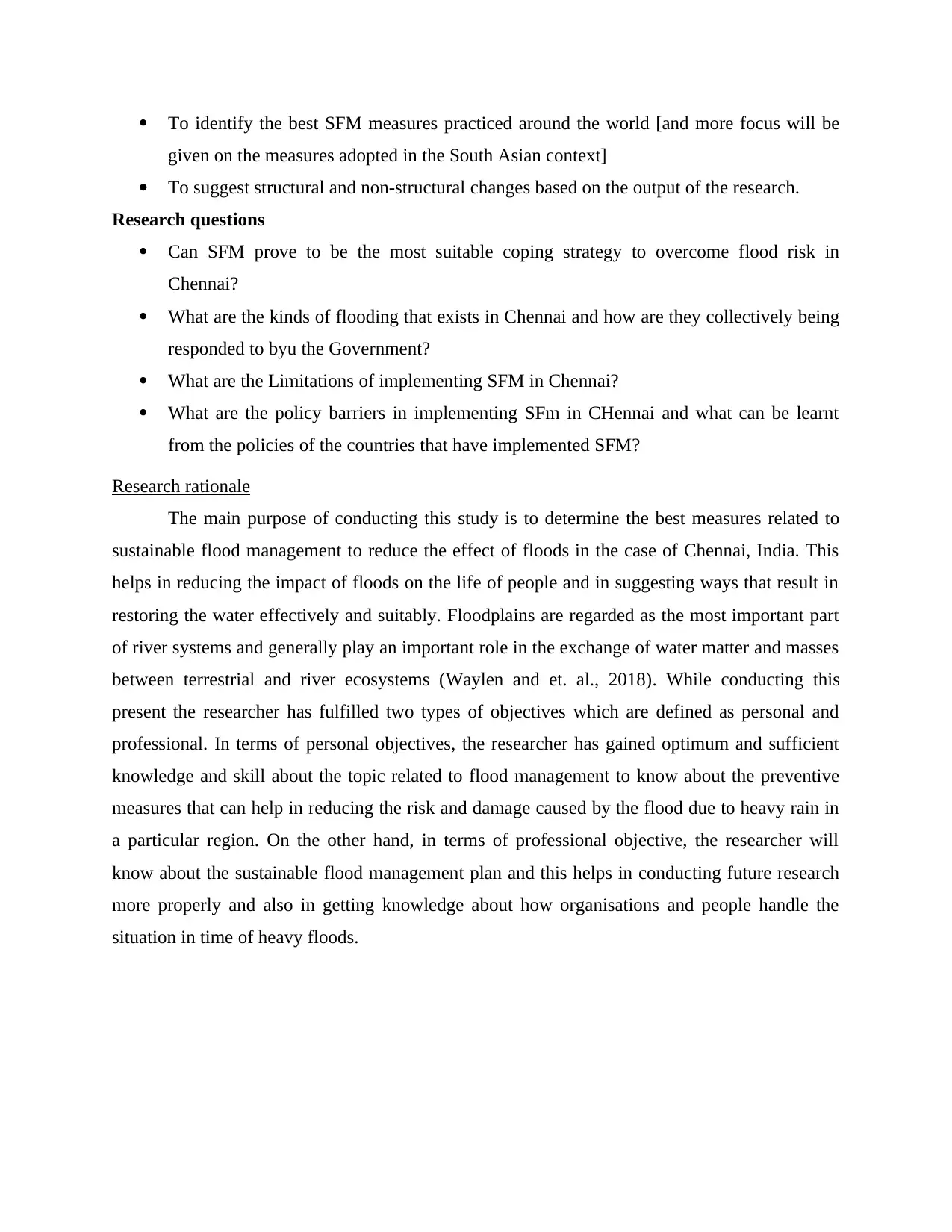
To identify the best SFM measures practiced around the world [and more focus will be
given on the measures adopted in the South Asian context]
To suggest structural and non-structural changes based on the output of the research.
Research questions
Can SFM prove to be the most suitable coping strategy to overcome flood risk in
Chennai?
What are the kinds of flooding that exists in Chennai and how are they collectively being
responded to byu the Government?
What are the Limitations of implementing SFM in Chennai?
What are the policy barriers in implementing SFm in CHennai and what can be learnt
from the policies of the countries that have implemented SFM?
Research rationale
The main purpose of conducting this study is to determine the best measures related to
sustainable flood management to reduce the effect of floods in the case of Chennai, India. This
helps in reducing the impact of floods on the life of people and in suggesting ways that result in
restoring the water effectively and suitably. Floodplains are regarded as the most important part
of river systems and generally play an important role in the exchange of water matter and masses
between terrestrial and river ecosystems (Waylen and et. al., 2018). While conducting this
present the researcher has fulfilled two types of objectives which are defined as personal and
professional. In terms of personal objectives, the researcher has gained optimum and sufficient
knowledge and skill about the topic related to flood management to know about the preventive
measures that can help in reducing the risk and damage caused by the flood due to heavy rain in
a particular region. On the other hand, in terms of professional objective, the researcher will
know about the sustainable flood management plan and this helps in conducting future research
more properly and also in getting knowledge about how organisations and people handle the
situation in time of heavy floods.
given on the measures adopted in the South Asian context]
To suggest structural and non-structural changes based on the output of the research.
Research questions
Can SFM prove to be the most suitable coping strategy to overcome flood risk in
Chennai?
What are the kinds of flooding that exists in Chennai and how are they collectively being
responded to byu the Government?
What are the Limitations of implementing SFM in Chennai?
What are the policy barriers in implementing SFm in CHennai and what can be learnt
from the policies of the countries that have implemented SFM?
Research rationale
The main purpose of conducting this study is to determine the best measures related to
sustainable flood management to reduce the effect of floods in the case of Chennai, India. This
helps in reducing the impact of floods on the life of people and in suggesting ways that result in
restoring the water effectively and suitably. Floodplains are regarded as the most important part
of river systems and generally play an important role in the exchange of water matter and masses
between terrestrial and river ecosystems (Waylen and et. al., 2018). While conducting this
present the researcher has fulfilled two types of objectives which are defined as personal and
professional. In terms of personal objectives, the researcher has gained optimum and sufficient
knowledge and skill about the topic related to flood management to know about the preventive
measures that can help in reducing the risk and damage caused by the flood due to heavy rain in
a particular region. On the other hand, in terms of professional objective, the researcher will
know about the sustainable flood management plan and this helps in conducting future research
more properly and also in getting knowledge about how organisations and people handle the
situation in time of heavy floods.
⊘ This is a preview!⊘
Do you want full access?
Subscribe today to unlock all pages.

Trusted by 1+ million students worldwide
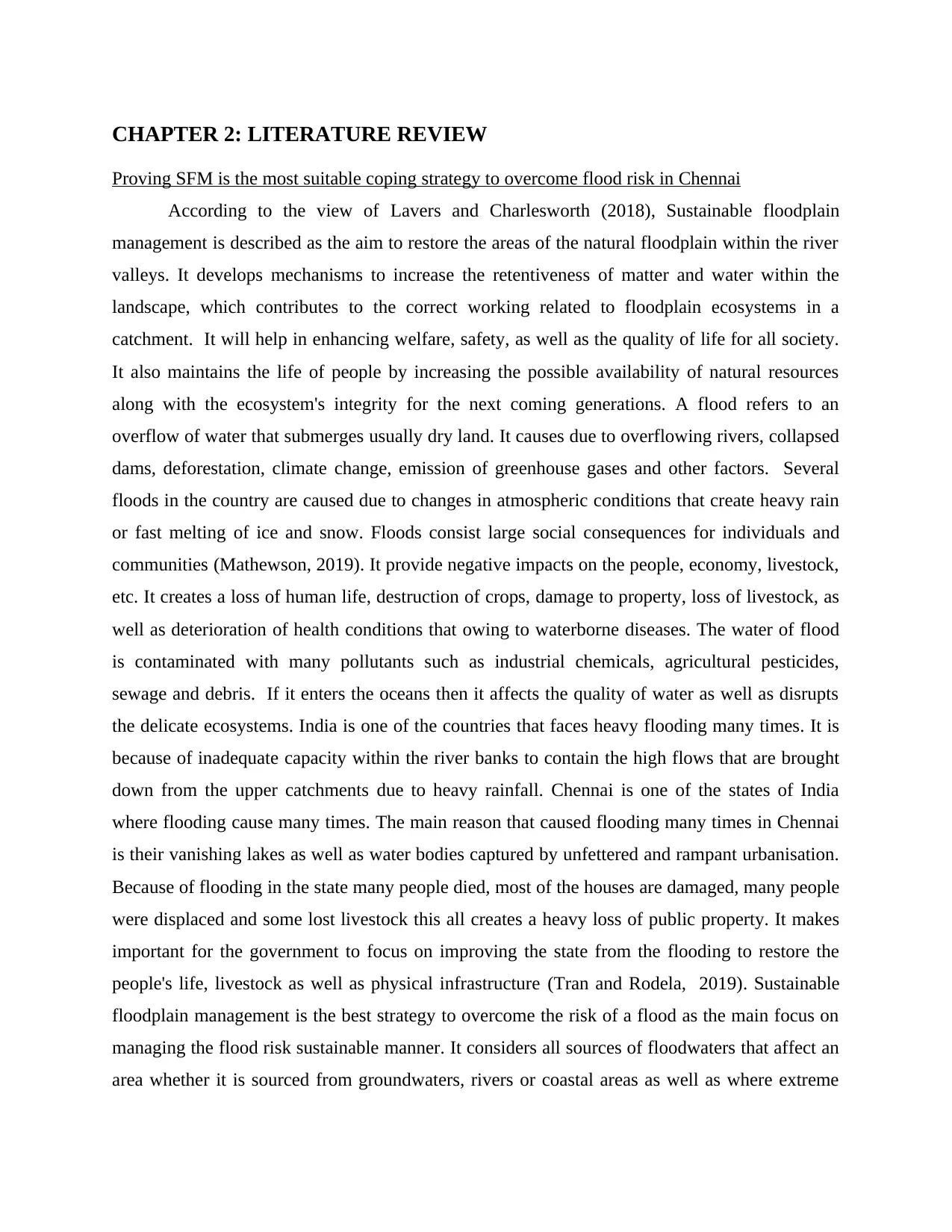
CHAPTER 2: LITERATURE REVIEW
Proving SFM is the most suitable coping strategy to overcome flood risk in Chennai
According to the view of Lavers and Charlesworth (2018), Sustainable floodplain
management is described as the aim to restore the areas of the natural floodplain within the river
valleys. It develops mechanisms to increase the retentiveness of matter and water within the
landscape, which contributes to the correct working related to floodplain ecosystems in a
catchment. It will help in enhancing welfare, safety, as well as the quality of life for all society.
It also maintains the life of people by increasing the possible availability of natural resources
along with the ecosystem's integrity for the next coming generations. A flood refers to an
overflow of water that submerges usually dry land. It causes due to overflowing rivers, collapsed
dams, deforestation, climate change, emission of greenhouse gases and other factors. Several
floods in the country are caused due to changes in atmospheric conditions that create heavy rain
or fast melting of ice and snow. Floods consist large social consequences for individuals and
communities (Mathewson, 2019). It provide negative impacts on the people, economy, livestock,
etc. It creates a loss of human life, destruction of crops, damage to property, loss of livestock, as
well as deterioration of health conditions that owing to waterborne diseases. The water of flood
is contaminated with many pollutants such as industrial chemicals, agricultural pesticides,
sewage and debris. If it enters the oceans then it affects the quality of water as well as disrupts
the delicate ecosystems. India is one of the countries that faces heavy flooding many times. It is
because of inadequate capacity within the river banks to contain the high flows that are brought
down from the upper catchments due to heavy rainfall. Chennai is one of the states of India
where flooding cause many times. The main reason that caused flooding many times in Chennai
is their vanishing lakes as well as water bodies captured by unfettered and rampant urbanisation.
Because of flooding in the state many people died, most of the houses are damaged, many people
were displaced and some lost livestock this all creates a heavy loss of public property. It makes
important for the government to focus on improving the state from the flooding to restore the
people's life, livestock as well as physical infrastructure (Tran and Rodela, 2019). Sustainable
floodplain management is the best strategy to overcome the risk of a flood as the main focus on
managing the flood risk sustainable manner. It considers all sources of floodwaters that affect an
area whether it is sourced from groundwaters, rivers or coastal areas as well as where extreme
Proving SFM is the most suitable coping strategy to overcome flood risk in Chennai
According to the view of Lavers and Charlesworth (2018), Sustainable floodplain
management is described as the aim to restore the areas of the natural floodplain within the river
valleys. It develops mechanisms to increase the retentiveness of matter and water within the
landscape, which contributes to the correct working related to floodplain ecosystems in a
catchment. It will help in enhancing welfare, safety, as well as the quality of life for all society.
It also maintains the life of people by increasing the possible availability of natural resources
along with the ecosystem's integrity for the next coming generations. A flood refers to an
overflow of water that submerges usually dry land. It causes due to overflowing rivers, collapsed
dams, deforestation, climate change, emission of greenhouse gases and other factors. Several
floods in the country are caused due to changes in atmospheric conditions that create heavy rain
or fast melting of ice and snow. Floods consist large social consequences for individuals and
communities (Mathewson, 2019). It provide negative impacts on the people, economy, livestock,
etc. It creates a loss of human life, destruction of crops, damage to property, loss of livestock, as
well as deterioration of health conditions that owing to waterborne diseases. The water of flood
is contaminated with many pollutants such as industrial chemicals, agricultural pesticides,
sewage and debris. If it enters the oceans then it affects the quality of water as well as disrupts
the delicate ecosystems. India is one of the countries that faces heavy flooding many times. It is
because of inadequate capacity within the river banks to contain the high flows that are brought
down from the upper catchments due to heavy rainfall. Chennai is one of the states of India
where flooding cause many times. The main reason that caused flooding many times in Chennai
is their vanishing lakes as well as water bodies captured by unfettered and rampant urbanisation.
Because of flooding in the state many people died, most of the houses are damaged, many people
were displaced and some lost livestock this all creates a heavy loss of public property. It makes
important for the government to focus on improving the state from the flooding to restore the
people's life, livestock as well as physical infrastructure (Tran and Rodela, 2019). Sustainable
floodplain management is the best strategy to overcome the risk of a flood as the main focus on
managing the flood risk sustainable manner. It considers all sources of floodwaters that affect an
area whether it is sourced from groundwaters, rivers or coastal areas as well as where extreme
Paraphrase This Document
Need a fresh take? Get an instant paraphrase of this document with our AI Paraphraser
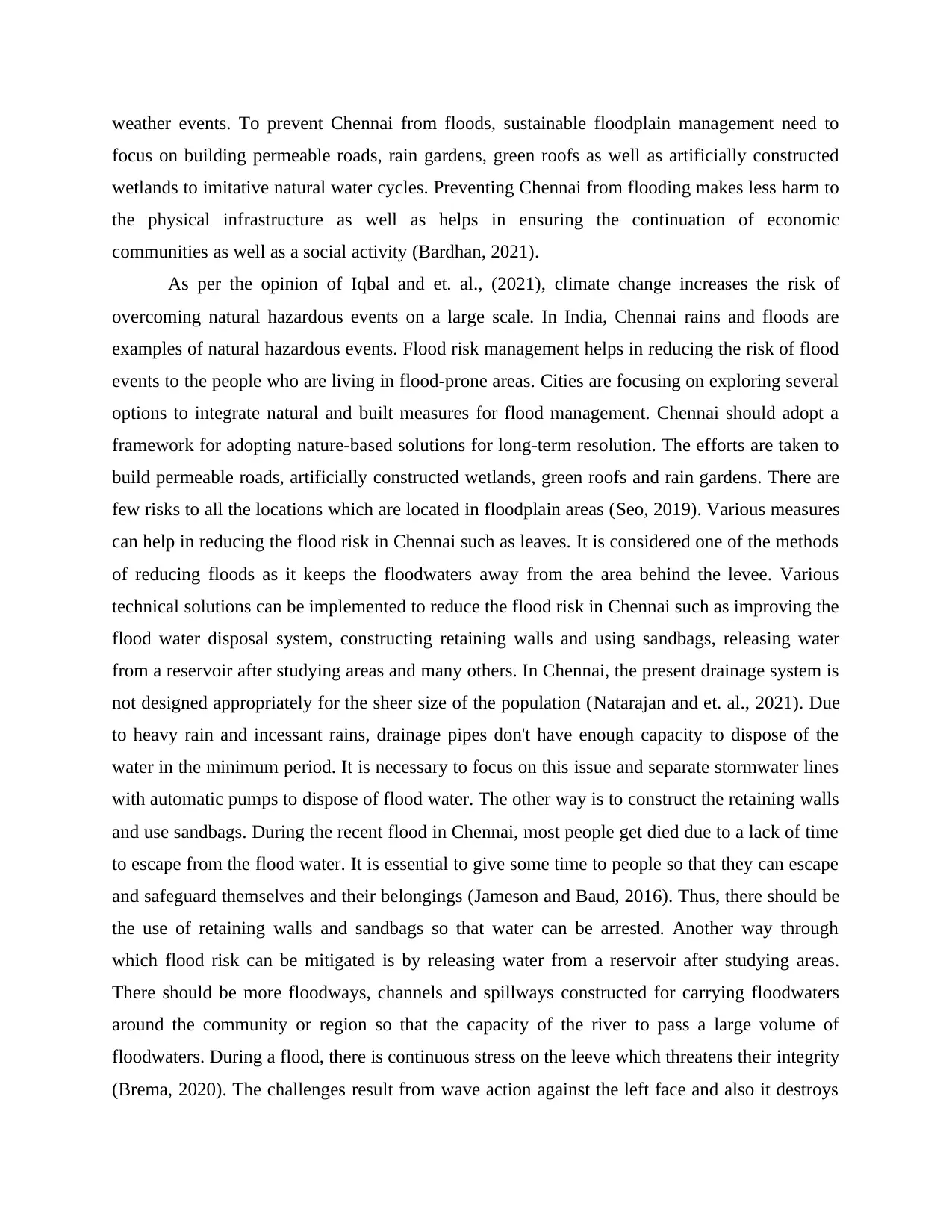
weather events. To prevent Chennai from floods, sustainable floodplain management need to
focus on building permeable roads, rain gardens, green roofs as well as artificially constructed
wetlands to imitative natural water cycles. Preventing Chennai from flooding makes less harm to
the physical infrastructure as well as helps in ensuring the continuation of economic
communities as well as a social activity (Bardhan, 2021).
As per the opinion of Iqbal and et. al., (2021), climate change increases the risk of
overcoming natural hazardous events on a large scale. In India, Chennai rains and floods are
examples of natural hazardous events. Flood risk management helps in reducing the risk of flood
events to the people who are living in flood-prone areas. Cities are focusing on exploring several
options to integrate natural and built measures for flood management. Chennai should adopt a
framework for adopting nature-based solutions for long-term resolution. The efforts are taken to
build permeable roads, artificially constructed wetlands, green roofs and rain gardens. There are
few risks to all the locations which are located in floodplain areas (Seo, 2019). Various measures
can help in reducing the flood risk in Chennai such as leaves. It is considered one of the methods
of reducing floods as it keeps the floodwaters away from the area behind the levee. Various
technical solutions can be implemented to reduce the flood risk in Chennai such as improving the
flood water disposal system, constructing retaining walls and using sandbags, releasing water
from a reservoir after studying areas and many others. In Chennai, the present drainage system is
not designed appropriately for the sheer size of the population (Natarajan and et. al., 2021). Due
to heavy rain and incessant rains, drainage pipes don't have enough capacity to dispose of the
water in the minimum period. It is necessary to focus on this issue and separate stormwater lines
with automatic pumps to dispose of flood water. The other way is to construct the retaining walls
and use sandbags. During the recent flood in Chennai, most people get died due to a lack of time
to escape from the flood water. It is essential to give some time to people so that they can escape
and safeguard themselves and their belongings (Jameson and Baud, 2016). Thus, there should be
the use of retaining walls and sandbags so that water can be arrested. Another way through
which flood risk can be mitigated is by releasing water from a reservoir after studying areas.
There should be more floodways, channels and spillways constructed for carrying floodwaters
around the community or region so that the capacity of the river to pass a large volume of
floodwaters. During a flood, there is continuous stress on the leeve which threatens their integrity
(Brema, 2020). The challenges result from wave action against the left face and also it destroys
focus on building permeable roads, rain gardens, green roofs as well as artificially constructed
wetlands to imitative natural water cycles. Preventing Chennai from flooding makes less harm to
the physical infrastructure as well as helps in ensuring the continuation of economic
communities as well as a social activity (Bardhan, 2021).
As per the opinion of Iqbal and et. al., (2021), climate change increases the risk of
overcoming natural hazardous events on a large scale. In India, Chennai rains and floods are
examples of natural hazardous events. Flood risk management helps in reducing the risk of flood
events to the people who are living in flood-prone areas. Cities are focusing on exploring several
options to integrate natural and built measures for flood management. Chennai should adopt a
framework for adopting nature-based solutions for long-term resolution. The efforts are taken to
build permeable roads, artificially constructed wetlands, green roofs and rain gardens. There are
few risks to all the locations which are located in floodplain areas (Seo, 2019). Various measures
can help in reducing the flood risk in Chennai such as leaves. It is considered one of the methods
of reducing floods as it keeps the floodwaters away from the area behind the levee. Various
technical solutions can be implemented to reduce the flood risk in Chennai such as improving the
flood water disposal system, constructing retaining walls and using sandbags, releasing water
from a reservoir after studying areas and many others. In Chennai, the present drainage system is
not designed appropriately for the sheer size of the population (Natarajan and et. al., 2021). Due
to heavy rain and incessant rains, drainage pipes don't have enough capacity to dispose of the
water in the minimum period. It is necessary to focus on this issue and separate stormwater lines
with automatic pumps to dispose of flood water. The other way is to construct the retaining walls
and use sandbags. During the recent flood in Chennai, most people get died due to a lack of time
to escape from the flood water. It is essential to give some time to people so that they can escape
and safeguard themselves and their belongings (Jameson and Baud, 2016). Thus, there should be
the use of retaining walls and sandbags so that water can be arrested. Another way through
which flood risk can be mitigated is by releasing water from a reservoir after studying areas.
There should be more floodways, channels and spillways constructed for carrying floodwaters
around the community or region so that the capacity of the river to pass a large volume of
floodwaters. During a flood, there is continuous stress on the leeve which threatens their integrity
(Brema, 2020). The challenges result from wave action against the left face and also it destroys
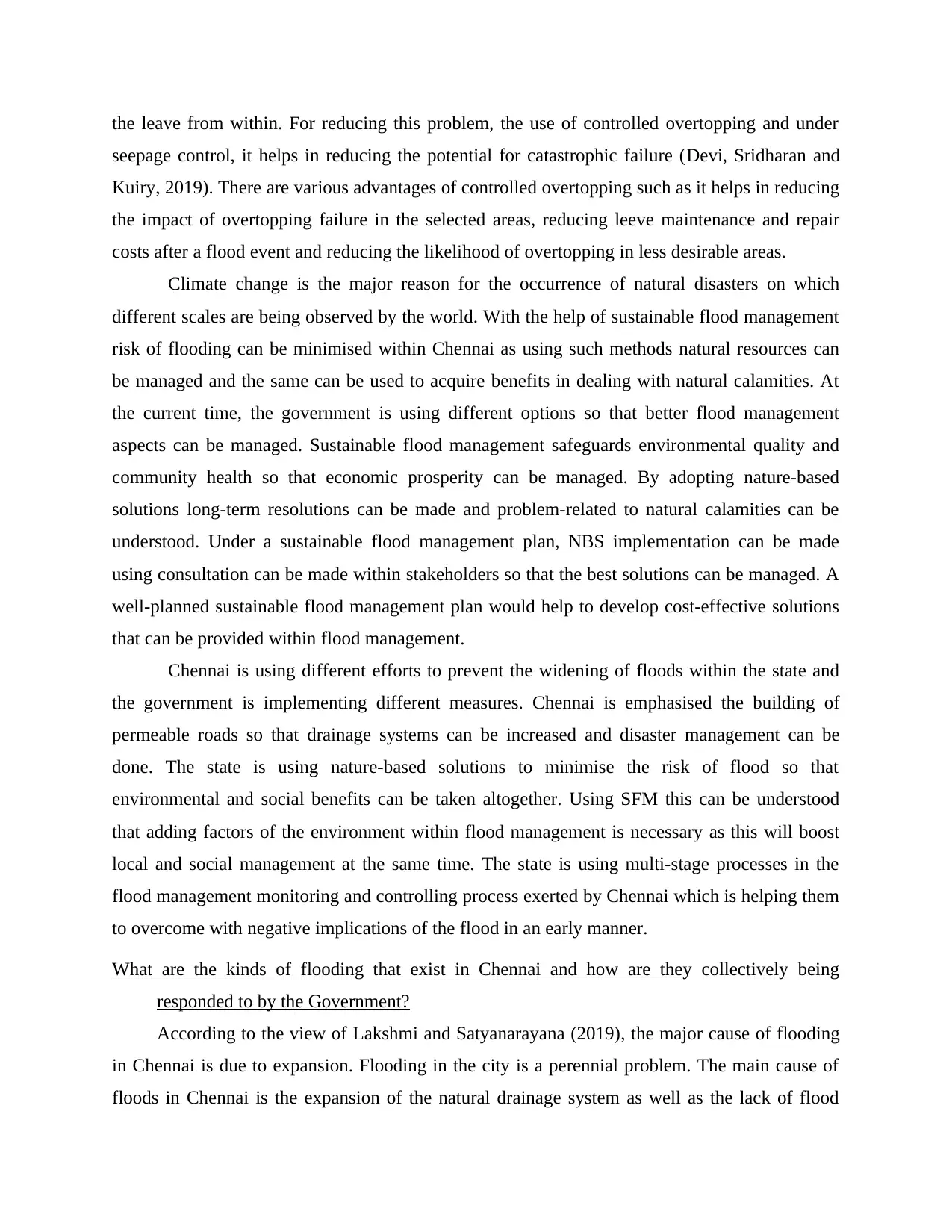
the leave from within. For reducing this problem, the use of controlled overtopping and under
seepage control, it helps in reducing the potential for catastrophic failure (Devi, Sridharan and
Kuiry, 2019). There are various advantages of controlled overtopping such as it helps in reducing
the impact of overtopping failure in the selected areas, reducing leeve maintenance and repair
costs after a flood event and reducing the likelihood of overtopping in less desirable areas.
Climate change is the major reason for the occurrence of natural disasters on which
different scales are being observed by the world. With the help of sustainable flood management
risk of flooding can be minimised within Chennai as using such methods natural resources can
be managed and the same can be used to acquire benefits in dealing with natural calamities. At
the current time, the government is using different options so that better flood management
aspects can be managed. Sustainable flood management safeguards environmental quality and
community health so that economic prosperity can be managed. By adopting nature-based
solutions long-term resolutions can be made and problem-related to natural calamities can be
understood. Under a sustainable flood management plan, NBS implementation can be made
using consultation can be made within stakeholders so that the best solutions can be managed. A
well-planned sustainable flood management plan would help to develop cost-effective solutions
that can be provided within flood management.
Chennai is using different efforts to prevent the widening of floods within the state and
the government is implementing different measures. Chennai is emphasised the building of
permeable roads so that drainage systems can be increased and disaster management can be
done. The state is using nature-based solutions to minimise the risk of flood so that
environmental and social benefits can be taken altogether. Using SFM this can be understood
that adding factors of the environment within flood management is necessary as this will boost
local and social management at the same time. The state is using multi-stage processes in the
flood management monitoring and controlling process exerted by Chennai which is helping them
to overcome with negative implications of the flood in an early manner.
What are the kinds of flooding that exist in Chennai and how are they collectively being
responded to by the Government?
According to the view of Lakshmi and Satyanarayana (2019), the major cause of flooding
in Chennai is due to expansion. Flooding in the city is a perennial problem. The main cause of
floods in Chennai is the expansion of the natural drainage system as well as the lack of flood
seepage control, it helps in reducing the potential for catastrophic failure (Devi, Sridharan and
Kuiry, 2019). There are various advantages of controlled overtopping such as it helps in reducing
the impact of overtopping failure in the selected areas, reducing leeve maintenance and repair
costs after a flood event and reducing the likelihood of overtopping in less desirable areas.
Climate change is the major reason for the occurrence of natural disasters on which
different scales are being observed by the world. With the help of sustainable flood management
risk of flooding can be minimised within Chennai as using such methods natural resources can
be managed and the same can be used to acquire benefits in dealing with natural calamities. At
the current time, the government is using different options so that better flood management
aspects can be managed. Sustainable flood management safeguards environmental quality and
community health so that economic prosperity can be managed. By adopting nature-based
solutions long-term resolutions can be made and problem-related to natural calamities can be
understood. Under a sustainable flood management plan, NBS implementation can be made
using consultation can be made within stakeholders so that the best solutions can be managed. A
well-planned sustainable flood management plan would help to develop cost-effective solutions
that can be provided within flood management.
Chennai is using different efforts to prevent the widening of floods within the state and
the government is implementing different measures. Chennai is emphasised the building of
permeable roads so that drainage systems can be increased and disaster management can be
done. The state is using nature-based solutions to minimise the risk of flood so that
environmental and social benefits can be taken altogether. Using SFM this can be understood
that adding factors of the environment within flood management is necessary as this will boost
local and social management at the same time. The state is using multi-stage processes in the
flood management monitoring and controlling process exerted by Chennai which is helping them
to overcome with negative implications of the flood in an early manner.
What are the kinds of flooding that exist in Chennai and how are they collectively being
responded to by the Government?
According to the view of Lakshmi and Satyanarayana (2019), the major cause of flooding
in Chennai is due to expansion. Flooding in the city is a perennial problem. The main cause of
floods in Chennai is the expansion of the natural drainage system as well as the lack of flood
⊘ This is a preview!⊘
Do you want full access?
Subscribe today to unlock all pages.

Trusted by 1+ million students worldwide
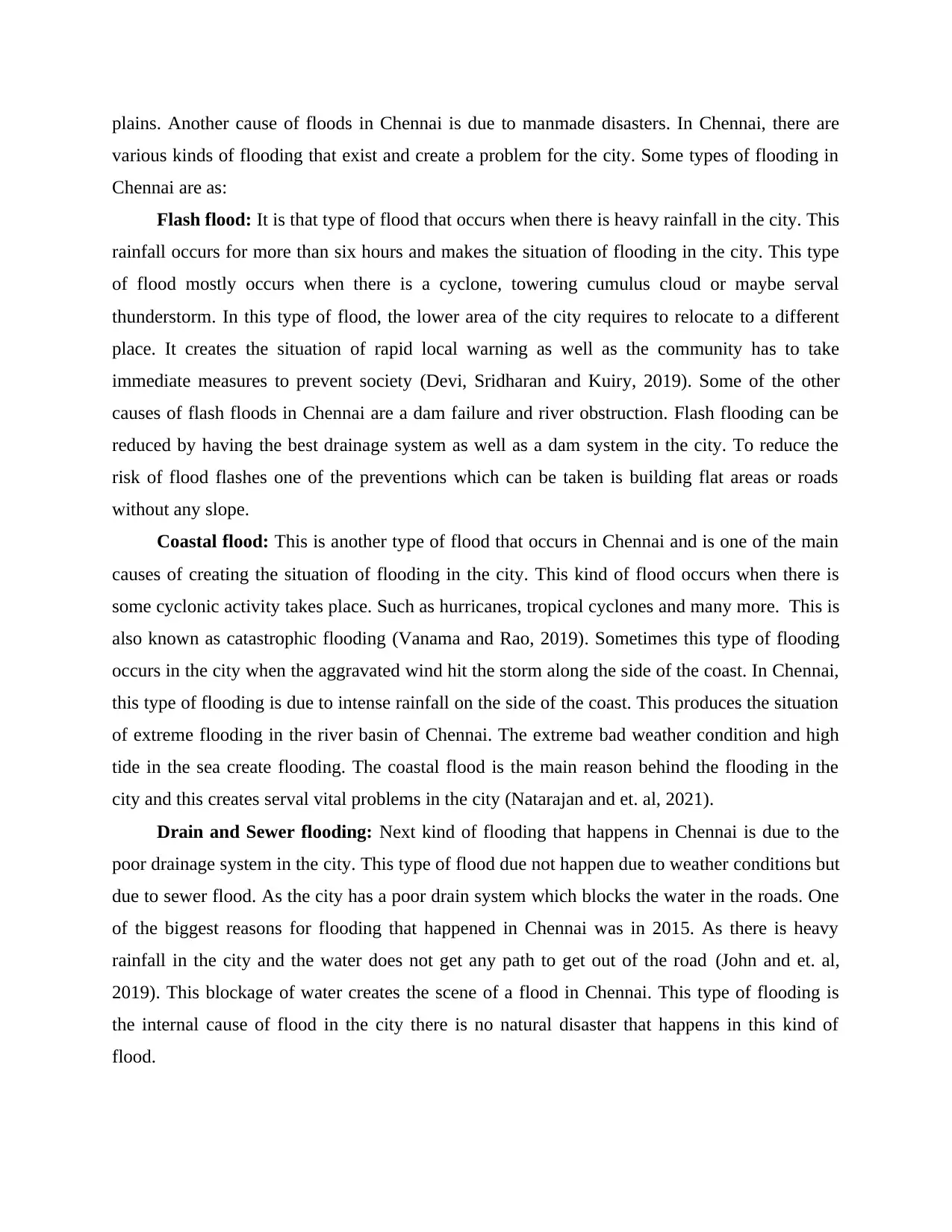
plains. Another cause of floods in Chennai is due to manmade disasters. In Chennai, there are
various kinds of flooding that exist and create a problem for the city. Some types of flooding in
Chennai are as:
Flash flood: It is that type of flood that occurs when there is heavy rainfall in the city. This
rainfall occurs for more than six hours and makes the situation of flooding in the city. This type
of flood mostly occurs when there is a cyclone, towering cumulus cloud or maybe serval
thunderstorm. In this type of flood, the lower area of the city requires to relocate to a different
place. It creates the situation of rapid local warning as well as the community has to take
immediate measures to prevent society (Devi, Sridharan and Kuiry, 2019). Some of the other
causes of flash floods in Chennai are a dam failure and river obstruction. Flash flooding can be
reduced by having the best drainage system as well as a dam system in the city. To reduce the
risk of flood flashes one of the preventions which can be taken is building flat areas or roads
without any slope.
Coastal flood: This is another type of flood that occurs in Chennai and is one of the main
causes of creating the situation of flooding in the city. This kind of flood occurs when there is
some cyclonic activity takes place. Such as hurricanes, tropical cyclones and many more. This is
also known as catastrophic flooding (Vanama and Rao, 2019). Sometimes this type of flooding
occurs in the city when the aggravated wind hit the storm along the side of the coast. In Chennai,
this type of flooding is due to intense rainfall on the side of the coast. This produces the situation
of extreme flooding in the river basin of Chennai. The extreme bad weather condition and high
tide in the sea create flooding. The coastal flood is the main reason behind the flooding in the
city and this creates serval vital problems in the city (Natarajan and et. al, 2021).
Drain and Sewer flooding: Next kind of flooding that happens in Chennai is due to the
poor drainage system in the city. This type of flood due not happen due to weather conditions but
due to sewer flood. As the city has a poor drain system which blocks the water in the roads. One
of the biggest reasons for flooding that happened in Chennai was in 2015. As there is heavy
rainfall in the city and the water does not get any path to get out of the road (John and et. al,
2019). This blockage of water creates the scene of a flood in Chennai. This type of flooding is
the internal cause of flood in the city there is no natural disaster that happens in this kind of
flood.
various kinds of flooding that exist and create a problem for the city. Some types of flooding in
Chennai are as:
Flash flood: It is that type of flood that occurs when there is heavy rainfall in the city. This
rainfall occurs for more than six hours and makes the situation of flooding in the city. This type
of flood mostly occurs when there is a cyclone, towering cumulus cloud or maybe serval
thunderstorm. In this type of flood, the lower area of the city requires to relocate to a different
place. It creates the situation of rapid local warning as well as the community has to take
immediate measures to prevent society (Devi, Sridharan and Kuiry, 2019). Some of the other
causes of flash floods in Chennai are a dam failure and river obstruction. Flash flooding can be
reduced by having the best drainage system as well as a dam system in the city. To reduce the
risk of flood flashes one of the preventions which can be taken is building flat areas or roads
without any slope.
Coastal flood: This is another type of flood that occurs in Chennai and is one of the main
causes of creating the situation of flooding in the city. This kind of flood occurs when there is
some cyclonic activity takes place. Such as hurricanes, tropical cyclones and many more. This is
also known as catastrophic flooding (Vanama and Rao, 2019). Sometimes this type of flooding
occurs in the city when the aggravated wind hit the storm along the side of the coast. In Chennai,
this type of flooding is due to intense rainfall on the side of the coast. This produces the situation
of extreme flooding in the river basin of Chennai. The extreme bad weather condition and high
tide in the sea create flooding. The coastal flood is the main reason behind the flooding in the
city and this creates serval vital problems in the city (Natarajan and et. al, 2021).
Drain and Sewer flooding: Next kind of flooding that happens in Chennai is due to the
poor drainage system in the city. This type of flood due not happen due to weather conditions but
due to sewer flood. As the city has a poor drain system which blocks the water in the roads. One
of the biggest reasons for flooding that happened in Chennai was in 2015. As there is heavy
rainfall in the city and the water does not get any path to get out of the road (John and et. al,
2019). This blockage of water creates the scene of a flood in Chennai. This type of flooding is
the internal cause of flood in the city there is no natural disaster that happens in this kind of
flood.
Paraphrase This Document
Need a fresh take? Get an instant paraphrase of this document with our AI Paraphraser
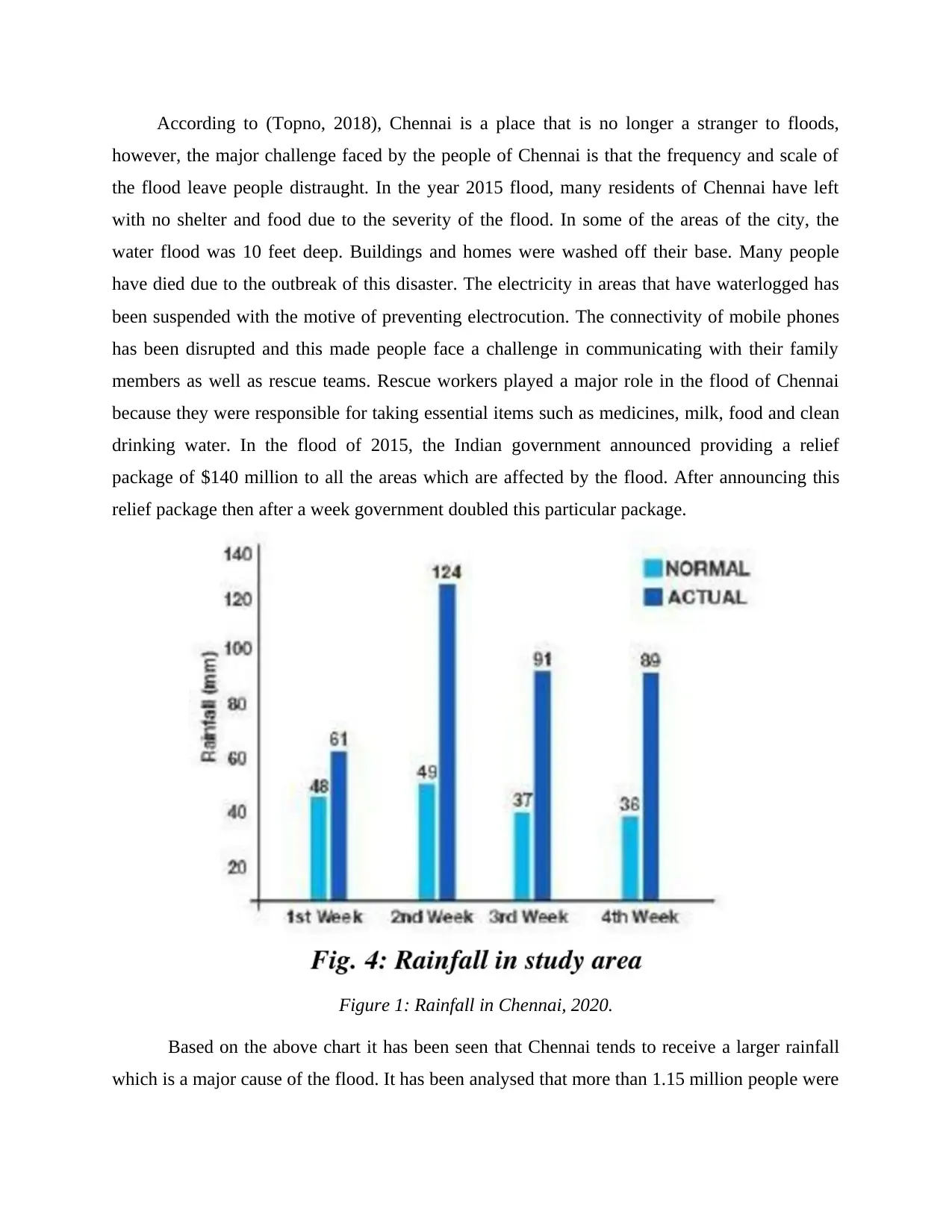
According to (Topno, 2018), Chennai is a place that is no longer a stranger to floods,
however, the major challenge faced by the people of Chennai is that the frequency and scale of
the flood leave people distraught. In the year 2015 flood, many residents of Chennai have left
with no shelter and food due to the severity of the flood. In some of the areas of the city, the
water flood was 10 feet deep. Buildings and homes were washed off their base. Many people
have died due to the outbreak of this disaster. The electricity in areas that have waterlogged has
been suspended with the motive of preventing electrocution. The connectivity of mobile phones
has been disrupted and this made people face a challenge in communicating with their family
members as well as rescue teams. Rescue workers played a major role in the flood of Chennai
because they were responsible for taking essential items such as medicines, milk, food and clean
drinking water. In the flood of 2015, the Indian government announced providing a relief
package of $140 million to all the areas which are affected by the flood. After announcing this
relief package then after a week government doubled this particular package.
Figure 1: Rainfall in Chennai, 2020.
Based on the above chart it has been seen that Chennai tends to receive a larger rainfall
which is a major cause of the flood. It has been analysed that more than 1.15 million people were
however, the major challenge faced by the people of Chennai is that the frequency and scale of
the flood leave people distraught. In the year 2015 flood, many residents of Chennai have left
with no shelter and food due to the severity of the flood. In some of the areas of the city, the
water flood was 10 feet deep. Buildings and homes were washed off their base. Many people
have died due to the outbreak of this disaster. The electricity in areas that have waterlogged has
been suspended with the motive of preventing electrocution. The connectivity of mobile phones
has been disrupted and this made people face a challenge in communicating with their family
members as well as rescue teams. Rescue workers played a major role in the flood of Chennai
because they were responsible for taking essential items such as medicines, milk, food and clean
drinking water. In the flood of 2015, the Indian government announced providing a relief
package of $140 million to all the areas which are affected by the flood. After announcing this
relief package then after a week government doubled this particular package.
Figure 1: Rainfall in Chennai, 2020.
Based on the above chart it has been seen that Chennai tends to receive a larger rainfall
which is a major cause of the flood. It has been analysed that more than 1.15 million people were
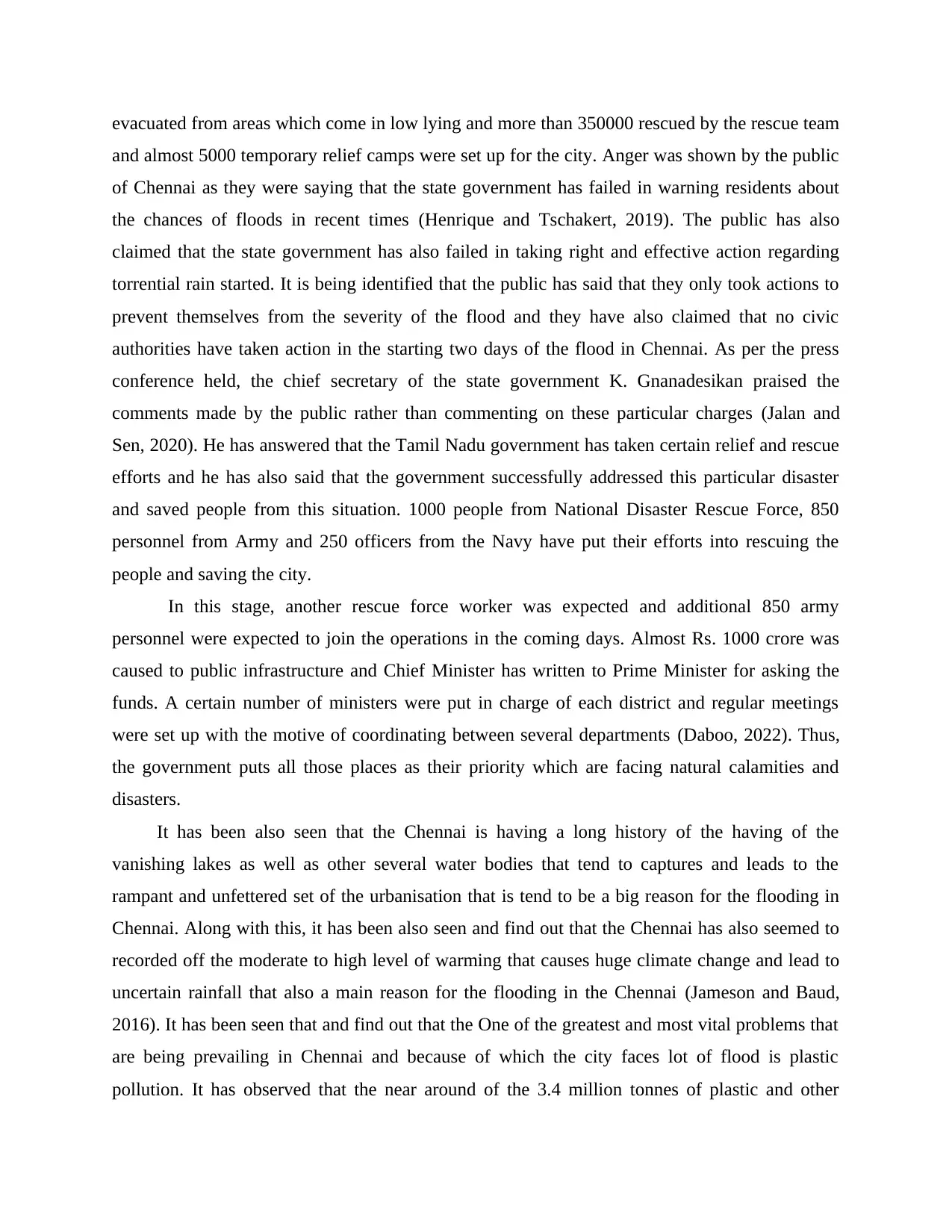
evacuated from areas which come in low lying and more than 350000 rescued by the rescue team
and almost 5000 temporary relief camps were set up for the city. Anger was shown by the public
of Chennai as they were saying that the state government has failed in warning residents about
the chances of floods in recent times (Henrique and Tschakert, 2019). The public has also
claimed that the state government has also failed in taking right and effective action regarding
torrential rain started. It is being identified that the public has said that they only took actions to
prevent themselves from the severity of the flood and they have also claimed that no civic
authorities have taken action in the starting two days of the flood in Chennai. As per the press
conference held, the chief secretary of the state government K. Gnanadesikan praised the
comments made by the public rather than commenting on these particular charges (Jalan and
Sen, 2020). He has answered that the Tamil Nadu government has taken certain relief and rescue
efforts and he has also said that the government successfully addressed this particular disaster
and saved people from this situation. 1000 people from National Disaster Rescue Force, 850
personnel from Army and 250 officers from the Navy have put their efforts into rescuing the
people and saving the city.
In this stage, another rescue force worker was expected and additional 850 army
personnel were expected to join the operations in the coming days. Almost Rs. 1000 crore was
caused to public infrastructure and Chief Minister has written to Prime Minister for asking the
funds. A certain number of ministers were put in charge of each district and regular meetings
were set up with the motive of coordinating between several departments (Daboo, 2022). Thus,
the government puts all those places as their priority which are facing natural calamities and
disasters.
It has been also seen that the Chennai is having a long history of the having of the
vanishing lakes as well as other several water bodies that tend to captures and leads to the
rampant and unfettered set of the urbanisation that is tend to be a big reason for the flooding in
Chennai. Along with this, it has been also seen and find out that the Chennai has also seemed to
recorded off the moderate to high level of warming that causes huge climate change and lead to
uncertain rainfall that also a main reason for the flooding in the Chennai (Jameson and Baud,
2016). It has been seen that and find out that the One of the greatest and most vital problems that
are being prevailing in Chennai and because of which the city faces lot of flood is plastic
pollution. It has observed that the near around of the 3.4 million tonnes of plastic and other
and almost 5000 temporary relief camps were set up for the city. Anger was shown by the public
of Chennai as they were saying that the state government has failed in warning residents about
the chances of floods in recent times (Henrique and Tschakert, 2019). The public has also
claimed that the state government has also failed in taking right and effective action regarding
torrential rain started. It is being identified that the public has said that they only took actions to
prevent themselves from the severity of the flood and they have also claimed that no civic
authorities have taken action in the starting two days of the flood in Chennai. As per the press
conference held, the chief secretary of the state government K. Gnanadesikan praised the
comments made by the public rather than commenting on these particular charges (Jalan and
Sen, 2020). He has answered that the Tamil Nadu government has taken certain relief and rescue
efforts and he has also said that the government successfully addressed this particular disaster
and saved people from this situation. 1000 people from National Disaster Rescue Force, 850
personnel from Army and 250 officers from the Navy have put their efforts into rescuing the
people and saving the city.
In this stage, another rescue force worker was expected and additional 850 army
personnel were expected to join the operations in the coming days. Almost Rs. 1000 crore was
caused to public infrastructure and Chief Minister has written to Prime Minister for asking the
funds. A certain number of ministers were put in charge of each district and regular meetings
were set up with the motive of coordinating between several departments (Daboo, 2022). Thus,
the government puts all those places as their priority which are facing natural calamities and
disasters.
It has been also seen that the Chennai is having a long history of the having of the
vanishing lakes as well as other several water bodies that tend to captures and leads to the
rampant and unfettered set of the urbanisation that is tend to be a big reason for the flooding in
Chennai. Along with this, it has been also seen and find out that the Chennai has also seemed to
recorded off the moderate to high level of warming that causes huge climate change and lead to
uncertain rainfall that also a main reason for the flooding in the Chennai (Jameson and Baud,
2016). It has been seen that and find out that the One of the greatest and most vital problems that
are being prevailing in Chennai and because of which the city faces lot of flood is plastic
pollution. It has observed that the near around of the 3.4 million tonnes of plastic and other
⊘ This is a preview!⊘
Do you want full access?
Subscribe today to unlock all pages.

Trusted by 1+ million students worldwide
1 out of 26
Your All-in-One AI-Powered Toolkit for Academic Success.
+13062052269
info@desklib.com
Available 24*7 on WhatsApp / Email
![[object Object]](/_next/static/media/star-bottom.7253800d.svg)
Unlock your academic potential
Copyright © 2020–2025 A2Z Services. All Rights Reserved. Developed and managed by ZUCOL.
